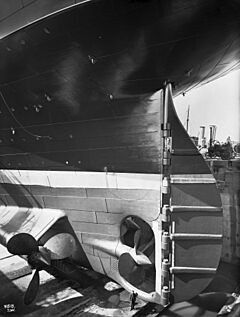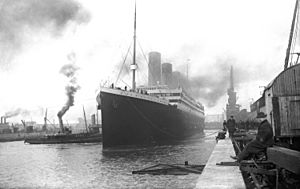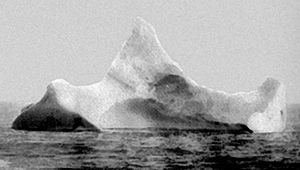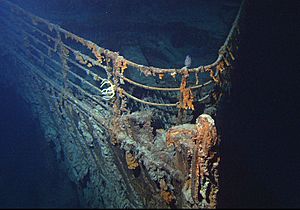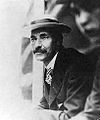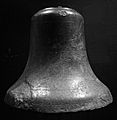Titanic facts for kids
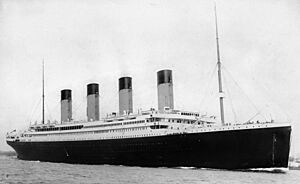
RMS Titanic leaving Southampton for its first and only voyage on April 10, 1912.
|
|
Quick facts for kids History |
|
|---|---|
| Name | RMS Titanic |
| Namesake | Titans |
| Owner | |
| Operator | White Star Line |
| Port of registry | |
| Route | Southampton to New York City |
| Ordered | 17 September 1908 |
| Builder | Harland and Wolff, Belfast |
| Cost | £1.5 million (about £170 million in today's money) |
| Yard number | 401 |
| Way number | 400 |
| Laid down | 31 March 1909 |
| Launched | 31 May 1911 |
| Completed | 2 April 1912 |
| Maiden voyage | 10 April 1912 |
| In service | 10 April 1912 |
| Out of service | 15 April 1912 |
| Identification | |
| Fate | Sank on April 15, 1912, after hitting an iceberg. |
| Status | Wreck |
| General characteristics | |
| Class and type | Olympic-class ocean liner |
| Tonnage | 46,329 GRT, 21,831 NRT |
| Displacement | 52,310 tonnes |
| Length | 882 ft 9 in (269.1 m) overall |
| Beam | 92 ft 6 in (28.2 m) |
| Height | 175 ft (53.3 m) (keel to top of funnels) |
| Draught | 34 ft 7 in (10.5 m) |
| Depth | 64 ft 6 in (19.7 m) |
| Decks | 9 (A–G) |
| Installed power | 24 double-ended and five single-ended boilers feeding two reciprocating steam engines for the side propellers, and a low-pressure turbine for the center propeller; output: 46,000 HP |
| Propulsion | Two three-blade side propellers and one center propeller |
| Speed |
|
| Capacity | 2,453 passengers and 874 crew (3,327 in total) |
| Notes | Lifeboats: 20 (enough for 1,178 people) |
RMS Titanic was a British passenger ship that sank in the North Atlantic Ocean on April 15, 1912. It hit an iceberg during its first-ever voyage from Southampton, England, to New York City. Of the 2,224 passengers and crew on board, more than 1,500 died. This makes it one of the deadliest sea disasters in peacetime history.
The Titanic was operated by the White Star Line. It carried some of the richest people in the world, as well as hundreds of people from Europe seeking a new life in America. The disaster led to major changes in ship safety rules and has been remembered in many books and movies.
When it was built, the Titanic was the largest ship in the world. It was the second of three giant ships built for the White Star Line, along with its sister ships Olympic and Britannic. The ship was built in Belfast, Ireland. Its captain was Edward John Smith, who went down with the ship.
The ship was famous for its luxury. First-class passengers had access to a gym, a swimming pool, fancy restaurants, and beautiful cabins. The Titanic also had advanced safety features for its time, like watertight compartments. Many people believed the ship was "unsinkable."
However, the Titanic did not have enough lifeboats for everyone on board. It had 20 lifeboats, which could only hold 1,178 people. This was about half the number of people on the ship. While this was more than the law required at the time, it was not enough to save everyone when the disaster happened.
Contents
Building a Giant Ship
The Titanic was named after the Titans of Greek mythology. It was built in Belfast by the shipbuilders Harland and Wolff. The company wanted to create a new class of ships that were bigger and more luxurious than any before. The Titanic and its sister ship, the Olympic, were built side-by-side.
Building these huge ships was a major challenge. A giant structure called a gantry was built over the ships to help lift heavy materials into place. The ship's hull was made of huge steel plates held together by over three million rivets.
Construction was difficult and dangerous work. For the 15,000 men who worked on the ship, safety rules were very basic. Sadly, eight people died during the ship's construction and launch.
Titanic was launched on May 31, 1911, in front of a crowd of 100,000 people. It then spent the next year being "fitted-out," which means its engines, funnels, and all its interior rooms and decorations were installed.
A Floating Palace
The Titanic had ten decks, eight of which were for passengers. The top deck was the Boat Deck, where the lifeboats were kept. Below this were several other decks with cabins, restaurants, and public rooms.
- First Class: The first-class areas were designed to be like a luxury hotel. The most famous feature was the Grand Staircase, made of oak and topped with a glass dome. First-class passengers could also use a gym, a swimming pool, a squash court, and even a Turkish bath.
- Second Class: Second-class accommodations were as nice as first class on many other ships. Passengers had their own library, smoking room, and dining room.
- Third Class: Even the third-class areas were better than on most other ships of the time. Instead of large dormitories, passengers had smaller, private cabins for two to ten people. They also had their own dining room and gathering spaces.
Power and Technology
The Titanic was powered by a combination of two huge steam engines and a modern turbine. This system was powerful and efficient. The engines turned three massive propellers to push the ship through the water.
The ship's power came from burning coal in 29 boilers. It took 176 firemen working around the clock to shovel coal into the furnaces.
One of the ship's most famous safety features was its 16 watertight compartments. These were sections of the ship that could be sealed off with special doors if there was a leak. The ship was designed to stay afloat even if four of these compartments flooded. This is why many people thought it was "unsinkable."
The ship had four funnels, but only three were used to release smoke from the boilers. The fourth one was just for looks and ventilation.
The First and Final Voyage
The Titanic began its maiden voyage on April 10, 1912. It sailed from Southampton, England, with over 900 passengers. As it left the dock, it narrowly missed hitting another ship, the SS New York.
The ship then crossed the English Channel to Cherbourg, France, to pick up more passengers. After that, it sailed to Queenstown (now Cobh), Ireland, to pick up its final group of passengers. On April 11, with about 2,224 people on board, the Titanic set off across the Atlantic Ocean for New York City.
The captain of the ship was Edward John Smith, who was the most experienced captain of the White Star Line. Many important and wealthy people were on board, including American millionaire John Jacob Astor IV and his wife Madeleine, and Macy's owner Isidor Straus and his wife Ida.
The Sinking
For the first few days, the voyage was smooth. But on the night of April 14, the weather became very cold and the sea was calm. The ship had received several warnings from other ships about drifting ice in the area. However, it was common practice at the time for ships to continue at high speed, relying on lookouts to spot any danger.
At 11:40 p.m., a lookout named Frederick Fleet spotted an iceberg directly in the ship's path. He alerted the bridge, and First Officer William McMaster Murdoch ordered the ship to turn and the engines to be put in reverse. But it was too late.
The right side of the Titanic scraped along the iceberg, creating holes below the waterline. Water began pouring into the ship's front compartments. The damage was too great; five compartments were flooding, one more than the ship could handle and still stay afloat. The crew quickly realized that the "unsinkable" Titanic was going to sink.
"Women and Children First"
As the ship began to sink, the crew started preparing the lifeboats. The rule of "women and children first" was generally followed. This meant that many men, including passengers and crew, were left behind.
There was a lot of confusion during the evacuation. The crew had not been trained on how to handle a full evacuation, and many lifeboats were launched only half-full. Because there were not enough lifeboats for everyone, over 1,500 people were still on the ship when it sank.
At 2:20 a.m. on April 15, just two hours and forty minutes after hitting the iceberg, the Titanic broke in two and sank into the freezing ocean. The survivors in the lifeboats could only watch.
A nearby ship, the RMS Carpathia, heard the Titanic's distress calls and rushed to help. It arrived about an-hour-and-a-half after the ship sank and rescued the 706 people in the lifeboats.
After the Disaster
The news of the sinking shocked the world. Inquiries were held in both the United States and the United Kingdom to find out what went wrong.
The inquiries found that:
- The ship was going too fast in an area known to have ice.
- The number of lifeboats required by law was outdated and not enough for large ships.
- The crew had not been properly trained for an emergency.
- A nearby ship, the SS Californian, had seen the Titanic's distress rockets but had not come to help.
The disaster led to major changes in maritime law. The first International Convention for the Safety of Life at Sea was created in 1914. New rules required all ships to carry enough lifeboats for every person on board. They also required lifeboat drills and 24-hour radio watch. The International Ice Patrol was also created to monitor icebergs in the North Atlantic.
Discovering the Wreck
For many years, people dreamed of finding the Titanic. But the wreck lay at a depth of over 12,000 feet (3,700 meters), where the water pressure is immense.
Finally, on September 1, 1985, a team led by Dr. Robert Ballard found the wreck using an underwater robot. They discovered that the ship had broken into two main pieces, which lay about a third of a mile apart on the ocean floor.
The area around the wreck is a large debris field, scattered with thousands of items from the ship, like furniture, dishes, and personal belongings.
Since its discovery, the wreck has been visited by many explorers and scientists. They have found that the ship is slowly being eaten by iron-eating bacteria. Some experts believe that in the next few decades, the wreck could collapse completely. Many items have been recovered from the debris field and are now displayed in museums around the world.
Legacy of the Titanic
The story of the Titanic has become a famous tale of tragedy and human error. It has inspired countless books, songs, and movies, including the 1997 film Titanic directed by James Cameron, which became one of the most successful films of all time.
Memorials to the victims were built in many cities, including Belfast, Southampton, New York, and Halifax, Nova Scotia, where many of the victims were buried. The city of Belfast, where the ship was built, is now home to a large museum called Titanic Belfast, which tells the story of the ship and the people who built it.
The Titanic serves as a powerful reminder of the importance of safety at sea and how even the most advanced technology can fail.
Amazing Titanic Facts
- The name Titanic comes from the Titans in Greek mythology.
- It was the largest ship afloat when it began service.
- The ship's total height, from the bottom to the top of the bridge, was 104 feet (32 m).
- The Titanic's electrical system could make more power than an average city power station at that time.
- The ship could hold 833 First Class, 614 Second Class, and 1,006 Third Class passengers. This was a total of 2,453 passengers.
- The Titanic's furnaces needed over 600 tonnes of coal each day. 176 firemen worked all the time to shovel coal.
- First-class passengers had a 7 ft (2.1 m) deep saltwater swimming pool, a gym, a squash court, and a Victorian-style Turkish bath.
- The dining room on D Deck was 114 ft (35 m) long and 92 ft (28 m) wide. It was the largest room on any ship and could seat almost 600 passengers.
- One of the Titanic's most famous features was the Grand Staircase. It was made of solid English oak and went down through seven decks.
- Titanic's owner, J. P. Morgan, was supposed to travel on the first trip but canceled at the last minute.
- The Titanic received warnings about icebergs near the Grand Banks of Newfoundland. However, Captain Smith did not act on them.
- When the ship sank, the lifeboats that were lowered were only filled to about 60% of their capacity.
Images for kids
-
RMS Titanic leaving Belfast for sea trials on April 2, 1912.
-
John Jacob Astor IV in 1909. He was the richest person on Titanic.
-
Titanic Belfast museum, 2012.
-
The sinking, sketched by J. Thayer on board the RMS Carpathia.
See Also
 In Spanish: RMS Titanic para niños
In Spanish: RMS Titanic para niños







